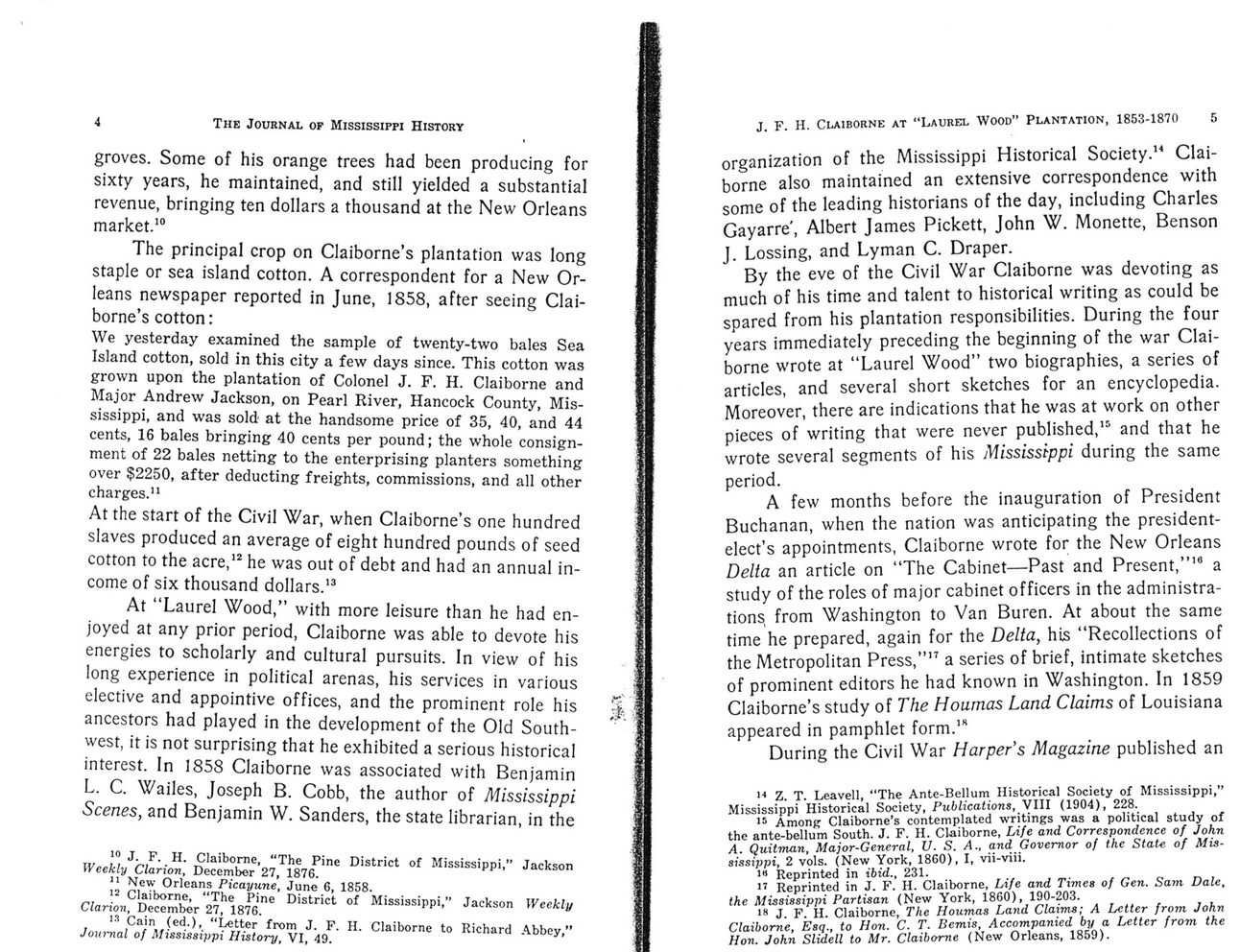This text was obtained via automated optical character recognition.
It has not been edited and may therefore contain several errors.
4 The Journal of Mississippi History groves. Some of his orange trees had been producing for sixty years, he maintained, and still yielded a substantial revenue, bringing ten dollars a thousand at the New Orleans market.10 The principal crop on Claiborne?s plantation was long staple or sea island cotton. A correspondent for a New Orleans newspaper reported in June, 1858, after seeing Claiborne?s cotton: We yesterday examined the sample of twenty-two bales Sea Island cotton, sold in this city a few days since. This cotton was grown upon the plantation of Colonel J. F. H. Claiborne and Major Andrew Jackson, on Pearl River, Hancock County, Mississippi, and was sold at the handsome price of 35, 40, and 44 cents, 16 bales bringing 40 cents per pound; the whole consignment of 22 bales netting to the enterprising planters something over $2250, after deducting freights, commissions, and all other charges.11 At the start of the Civil War, when Claiborne?s one hundred slaves produced an average of eight hundred pounds of seed cotton to the acre,12 he was out of debt and had an annual income of six thousand dollars.13 At ?Laurel Wood,? with more leisure than he had enjoyed at any prior period, Claiborne was able to devote his energies to scholarly and cultural pursuits. In view of his long experience in political arenas, his services in various elective and appointive offices, and the prominent role his ancestors had played in the development of the Old Southwest, it is not surprising that he exhibited a serious historical interest. In 1858 Claiborne was associated with Benjamin L. C. Wailes, Joseph B. Cobb, the author of Mississippi Scenes, and Benjamin W. Sanders, the state librarian, in the 10 J. F. H. Claiborne, ?The Pine District of Mississippi,? Jackson Weekly Clarion, December 27, 1876. 11 New Orleans Picayune, June 6, 1858. 12 Claiborne, ?The Pine District of Mississippi,? Jackson Weekly Clarion, December 27, 1876. 13 Cain (ed.), ?Letter from J. F. H. Claiborne to Richard Abbey,? Journal of Mississippi History, VI, 49. J. F. H. Claiborne at ?Laurel Wood? Plantation, 1853-1870 5 organization of the Mississippi Historical Society.14 Claiborne also maintained an extensive correspondence with some of the leading historians of the day, including Charles Gayarre', Albert James Pickett, John W. Monette, Benson J. Lossing, and Lyman C. Draper. By the eve of the Civil War Claiborne was devoting as much of his time and talent to historical writing as could be spared from his plantation responsibilities. During the four years immediately preceding the beginning of the war Claiborne wrote at ?Laurel Wood? two biographies, a series of articles, and several short sketches for an encyclopedia. Moreover, there are indications that he was at work on other pieces of writing that were never published,15 and that he wrote several segments of his Mississippi during the same period. A few months before the inauguration of President Buchanan, when the nation was anticipating the presidentelect?s appointments, Claiborne wrote for the New Orleans Delta an article on ?The Cabinet?Past and Present,?16 a study of the roles of major cabinet officers in the administrations from Washington to Van Buren. At about the same time he prepared, again for the Delta, his ?Recollections of the Metropolitan Press,?17 a series of brief, intimate sketches of prominent editors he had known in Washington. In 1859 Claiborne?s study of The Houmas Land Claims of Louisiana appeared in pamphlet form.18 During the Civil War Harpers Magazine published an 14 Z. T. Leavell, ?The Ante-Bellum Historical Society of Mississippi,? Mississippi Historical Society, Publications, VIII (1904), 228. 15 Among Claiborne?s contemplated writings was a political study of the ante-bellum South. J. F. H. Claiborne, Life and Correspondence of John A. Quitman, Major-General, V. S. A., and Governor of the State of Mississippi, 2 vols. (New York, 1860), I, vii-viii. IH Reprinted in ibid., 231. 17 Reprinted in J. F. H. Claiborne, Life and Times of Gen. Sam Dale, the Mississippi Partisan (New York, 1860), 190-203. 18 J. F. H. Claiborne, The Houmas Land Claims; A Letter from. John Claiborne, Esq., to Hon. C. T. Bemis, Accompanied by a Letter from the Hon. John Sluiell to Mr. Claiborne (New Orleans, 1859).

Claiborne, J.F.H Claiborne-J.F.H-112